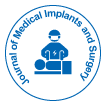Advancements in Biodegradable Implants: Pioneering Innovations in Drug Delivery and Tissue Regeneration
Received: 01-Jan-2024 / Manuscript No. jmis-25-160837 / Editor assigned: 03-Jan-2024 / PreQC No. jmis-25-160837 (PQ) / Reviewed: 17-Jan-2024 / QC No. jmis-25-160837 / Revised: 22-Jan-2024 / Manuscript No. jmis-25-160837 (R) / Published Date: 29-Jan-2024 DOI: 10.4172/jmis.1000211
Introduction
Biodegradable implants represent a significant innovation in the field of medical devices, offering an environmentally friendly and patient-centered alternative to traditional implants. Unlike conventional implants, which are designed to remain in the body indefinitely, biodegradable implants are crafted from materials that naturally degrade over time, eliminating the need for a second surgery to remove the device [1]. This characteristic makes them particularly attractive for a range of medical applications, including drug delivery and tissue regeneration. The use of biodegradable implants in drug delivery systems offers a unique approach to providing controlled, localized release of therapeutic agents over an extended period [2]. By incorporating bioactive materials, these implants can deliver drugs directly to the site of injury or disease, enhancing therapeutic effectiveness while minimizing systemic side effects. Additionally, biodegradable implants can support tissue regeneration by providing scaffolding that encourages cell growth, repair, and integration with surrounding tissues. Recent advancements in biomaterials, including biodegradable polymers, composites, and ceramics, have significantly improved the functionality and performance of these implants [3-5]. Researchers are continually developing new materials that offer better control over degradation rates, improved mechanical properties, and enhanced biocompatibility, which are essential for the long-term success of biodegradable implants in clinical settings. Despite these advancements, challenges such as the optimization of degradation rates, material strength, and long-term efficacy remain obstacles to the widespread adoption of biodegradable implants [6]. This article explores the future of biodegradable implants, focusing on the innovations in drug delivery and tissue regeneration applications. It examines the current state of the technology, the potential for these implants to revolutionize medical treatments, and the challenges that must be addressed to ensure their success in clinical practice.
Methodology
To explore the advancements and future prospects of biodegradable implants in drug delivery and tissue regeneration, a comprehensive literature review was conducted. This review focused on peer-reviewed articles, clinical trials, and case studies published within the last decade to identify key innovations, challenges, and future directions in the field [7,8]. A systematic search of relevant databases, including PubMed, Scopus, and Google Scholar, was carried out using keywords such as "biodegradable implants," drug delivery, "tissue regeneration," and "biomaterials." The selected studies were analyzed based on their relevance to biodegradable implant applications, including material properties, degradation mechanisms, and clinical outcomes [9]. Additionally, the review considered advancements in material science, specifically the development of biodegradable polymers, composites, and ceramics, which are integral to the success of these implants. Studies on in vitro and in vivo models were included to assess the effectiveness and safety of biodegradable implants in drug delivery and tissue regeneration applications [10]. Finally, the review identified the challenges associated with biodegradable implant technology, such as the need for precise control over degradation rates and the optimization of material properties for specific clinical applications.
Conclusion
Biodegradable implants hold immense promise for revolutionizing medical treatments in areas such as drug delivery and tissue regeneration. The ability to deliver therapeutic agents directly to the site of action, coupled with the ability to degrade naturally within the body, offers several advantages over traditional implantable devices. Advances in biomaterial technologies have led to the development of implants with improved biocompatibility, controlled degradation rates, and enhanced mechanical properties, making them suitable for a wide range of clinical applications. While the potential benefits of biodegradable implants are significant, challenges remain in optimizing the degradation rates, material strength, and long-term efficacy of these devices. Further research is needed to develop more reliable and customizable materials that can meet the specific needs of patients and clinicians. Additionally, addressing regulatory concerns and ensuring the safe and effective clinical use of biodegradable implants are crucial for their widespread adoption. Overall, the future of biodegradable implants in drug delivery and tissue regeneration looks promising, with ongoing innovations in materials science, 3D printing, and regenerative medicine. As these technologies continue to evolve, biodegradable implants are poised to play a key role in advancing personalized healthcare and providing more effective, less invasive treatment options for patients worldwide.
Acknowledgement
None
Conflict of Interest
None
Reference
- Humayun MS, Dorn JD, da Cruz L (2012). Ophthalmology 119: 779-788.
- Besch D, Sachs H, Szurman P (2008). The British J Ophthal 92: 1361-1368.
- O'Donoghue GM, Nikolopoulos TP (2002). Otology & Neuro 23: 891-894.
- Stingl K, Bartz-Schmidt KU, Besch D (2015). Vision Rese 111: 149-160.
- Spencer LJ, Barker BA, Tomblin JB (2013). Ear & Hearing 24: 236-247.
- Lichtenstein EH (1998). J Deaf Stud & Deaf Educ 2: 80-134.
- Gormley KA, Sarachan-Deily AB (1987). The Volta Review 89: 157-176.
- Yasamsal A, Yucel E, Sennaroglu G (2013). J Inter Adva Otology 9: 38-45.
- Schiller NO (1999). Brain & Language 68: 300-305.
- Moog JS, Geers AE (1999). Otolaryng Clin North America 32: 1127-1141.
, ,
, ,
, ,
, ,
, ,
, ,
, ,
, ,
, ,
, ,
Share This Article
Recommended Conferences
Toronto, Canada
Recommended Journals
黑料网 Journals
Article Tools
Article Usage
- Total views: 106
- [From(publication date): 0-0 - Mar 10, 2025]
- Breakdown by view type
- HTML page views: 74
- PDF downloads: 32
